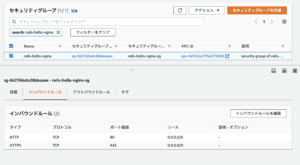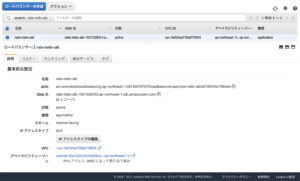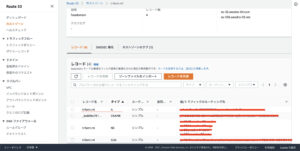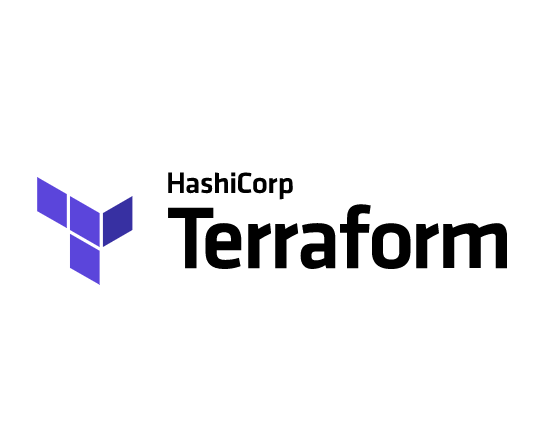AWSにRails + Nginxな環境をTerraformで構築してみようと思います。
はじめに
本連載で一つずつインフラを構築していきます。
ドメインのhttps化したり、ECSを使用したコンテナオーケストレーションを用いてアプリケーションをデプロイします。
この記事ではロードバランサーの構築をします。
環境は以下です。
| OS | Cataline 10.15.6 |
| Terraform | 0.14.4 |
基本構文などこちらにまとめてますので、よかったらみてください!
AWS Terraform 基本コード まとめ
連載一覧
- terraform AWS環境構築 事前準備
- 【ネットワーク環境構築】terraform AWS環境構築 第1回
- 【ドメインhttps化・ACM(SSL)証明書発行】terraform AWS環境構築 第2回
- 【ロードバランサー構築】terraform AWS環境構築 第3回 ←ここ
- 【ECS Fargate(nginx)実行】terraform AWS環境構築 第4回
- 【RDS構築】terraform AWS環境構築 第5回
- 【Docker/ECR作成】terraform AWS環境構築 第6回
- 【ECS Fargate(rails + nginx)実行】terraform AWS環境構築 第7回
- 【CircleCIによるCI/CD】terraform AWS環境構築 番外
やること
以下の定義と作成をします。
ロードバランサー構築
elbモジュールの作成
ロードバランサーを構築するモジュールを作成します。
terraformフォルダ内にelbフォルダを作成しましょう。
elbモジュールを使用できるよう./main.tfに以下の記述を追記します。
./main.tf
module "elb" {
source = "./elb"
app_name = var.app_name
}
elbモジュール内でapp_nameを受け取れるように、variable.tfを用意します。
./elb/variable.tf
variable "app_name" {}
ディレクトリ構成は以下のようにしています。
[terraform] $ tree . ├── acm │ ├── main.tf │ └── variable.tf ├── network │ ├── main.tf │ └── variable.tf ├── elb │ └──main.tf ├── env │ └── backend.config ├── main.tf ├── backend.tf ├── provider.tf ├── terraform.tfvars └── variable.tf
用意できたら、terraformの初期化を行いましょう。
[terraform] $ terraform init -backend-config=env/backend.config -upgradeセキュリティーグループの作成
ロードバランサー用のセキュリティーグループを作成します。
セキュリティーポートのインプット変数とnetworkモジュールからvpc idを取得できるようにします。
./main.tf のelbモジュールにvpc_idを追記します。
module "elb" {
source = "./elb"
app_name = var.app_name
# 追加
vpc_id = module.network.vpc_id
}
./elb/variable.tf に以下を追記します。
variable "vpc_id" {}
variable "ingress_ports" {
type = list(number)
description = "list of ingress ports"
default = [80, 443]
}
./elb/main.tf に以下を追記します。
resource "aws_security_group" "security_group" {
name = "${var.app_name}-alb"
vpc_id = var.vpc_id
dynamic "ingress" {
for_each = var.ingress_ports
iterator = port
content {
from_port = port.value
to_port = port.value
protocol = "tcp"
cidr_blocks = ["0.0.0.0/0"]
}
}
egress {
from_port = 0
to_port = 0
protocol = "-1"
cidr_blocks = ["0.0.0.0/0"]
}
tags = {
Name = "${var.app_name}-sg"
}
}
- name:セキュリティーグループ名
- vpc_id:紐付けるvpc id
- ingress:インバウンドルール
- from_port, to_port:ポート範囲
- protocol:プロトコル
- cidr_blocks:CIDRブロック
- egress:アウトバウンドルール
- from_port, to_port:ポート範囲
- protocol:プロトコル
- cidr_blocks:CIDRブロック
これで、セキュリティーグループの定義は完了です。


アプリケーションロードバランサーの作成
アプリケーションロードバランサーの定義をします。
ロードバランスするサブネットをnetworkモジュールから取得できるようにします。
./main.tf のelbモジュールにpublic_subnet_idsを追記します。
module "elb" {
source = "./elb"
app_name = var.app_name
vpc_id = module.network.vpc_id
# 追記
public_subnet_ids = module.network.public_subnet_ids
}
./elb/variable.tf に以下を追記します。
variable "public_subnet_ids" {}
./elb/main.tf に以下を追記します。
resource "aws_lb" "alb" {
name = "rails-hello-alb"
load_balancer_type = "application"
security_groups = [aws_security_group.security_group.id]
subnets = var.public_subnet_ids
}
- name:ロードバランサー名
- load_balancer_type:ロードバランサーの種類
- security_groups:セキュリティーグループ
- subnets:サブネット
terraform plan, apply して作成されるか見てみましょう。

アプリケーションロードバランサーの作成は完了です。
リスナーの作成
ロードバランサーが接続できるようにリスナーを定義します。
httpsのリスナーを追加できるように前回作成したacm証明書を使用するので、acmモジュールからacm証明書のidを取得できるようにします。
./main.tf のelbモジュールにacm_idを追記します。
module "elb" {
source = "./elb"
app_name = var.app_name
vpc_id = module.network.vpc_id
public_subnet_ids = module.network.public_subnet_ids
# 追記
acm_id = module.acm.acm_id
}
./elb/variable.tf に以下を追記します。
variable "acm_id" {}
./elb/main.tf に以下を追記します。
resource "aws_lb_listener" "http" {
# HTTPでのアクセスを受け付ける
port = "80"
protocol = "HTTP"
load_balancer_arn = aws_lb.alb.arn
# "ok" という固定レスポンスを設定する
default_action {
type = "fixed-response"
fixed_response {
content_type = "text/plain"
status_code = "200"
message_body = "ok"
}
}
}
resource "aws_lb_listener" "https" {
port = "443"
protocol = "HTTPS"
load_balancer_arn = aws_lb.alb.arn
certificate_arn = var.acm_id
default_action {
type = "fixed-response"
fixed_response {
content_type = "text/plain"
status_code = "200"
message_body = "ok"
}
}
}
- port:ポート番号
- protocol:プロトコル
- load_balancer_arn:紐付けるロードバランサーのarn
- certificate_arn:acm証明書のid
- default_action:アクションブロック
- type:ルーティングアクション
terraform plan, apply して作成されるか見てみましょう。

http・httpsのリスナー追加は完了です。
ロードバランサーのAレコード
Route53に登録したドメインでロードバランサーに飛ぶように、Aレコードを作成します。
ドメイン名とドメインのホストゾーンを使用します。
ドメイン名は、./main.tfのelbモジュールにdomainを追記します。
module "elb" {
source = "./elb"
app_name = var.app_name
vpc_id = module.network.vpc_id
public_subnet_ids = module.network.public_subnet_ids
acm_id = module.acm.acm_id
# 追記
domain = var.domain
}
./elb/variable.tf に以下を追記します。
variable "domain" {}
ホストゾーンは、Data Sourceで取得します。
./elb/data.tf
data "aws_route53_zone" "this" {
name = var.domain
private_zone = false
}
./elb/main.tf に以下を追記します。
resource "aws_route53_record" "this" {
type = "A"
name = var.domain
zone_id = data.aws_route53_zone.this.id
alias {
name = aws_lb.alb.dns_name
zone_id = aws_lb.alb.zone_id
evaluate_target_health = true
}
}
- name:レコード名
- type:レコードタイプ
- zone_id:ホストゾーンのID
- alias:エイリアス
- name:DNS
- zone_id:ホストゾーン
- evaluate_target_health:指定されたリソースのヘルスを評価するかどうか
それでは、terraform plan, apply して確認しましょう。

Aレコードが追加が確認できたと思います。
登録したドメインにアクセスしてokが表示されていると思います。

これで、完了です!
まとめ
ロードバランサーのリスナーはECS作成の際、リスナールールの追加を行うので、アウトプット変数を定義しておきましょう。
./elb/output.tf
output "http_listener_arn" {
value = aws_lb_listener.http.arn
}
output "https_listener_arn" {
value = aws_lb_listener.https.arn
}
今回、作成したコードとディレクトリ構成は以下になります。
[terraform] $ tree . ├── elb │ ├── data.tf │ ├── main.tf │ ├── output.tf │ └── variable.tf ├── acm │ ├── data.tf │ ├── main.tf │ ├── output.tf │ └── variable.tf ├── network │ ├── main.tf │ ├── output.tf │ └── variable.tf ├── env │ └── backend.config ├── main.tf ├── output.tf ├── backend.tf ├── provider.tf ├── terraform.tfvars └── variable.tf
./elb/main.tf
resource "aws_security_group" "security_group" {
name = "${var.app_name}-alb"
vpc_id = var.vpc_id
dynamic "ingress" {
for_each = var.ingress_ports
iterator = port
content {
from_port = port.value
to_port = port.value
protocol = "tcp"
cidr_blocks = ["0.0.0.0/0"]
}
}
egress {
from_port = 0
to_port = 0
protocol = "-1"
cidr_blocks = ["0.0.0.0/0"]
}
tags = {
Name = "${var.app_name}-sg"
}
}
resource "aws_lb" "alb" {
name = "rails-hello-alb"
load_balancer_type = "application"
security_groups = [aws_security_group.security_group.id]
subnets = var.public_subnet_ids
}
resource "aws_lb_listener" "http" {
# HTTPでのアクセスを受け付ける
port = "80"
protocol = "HTTP"
# ALBのarnを指定します。
#XXX: arnはAmazon Resource Names の略で、その名の通りリソースを特定するための一意な名前(id)です。
load_balancer_arn = aws_lb.alb.arn
# "ok" という固定レスポンスを設定する
default_action {
type = "fixed-response"
fixed_response {
content_type = "text/plain"
status_code = "200"
message_body = "ok"
}
}
}
resource "aws_lb_listener" "https" {
port = "443"
protocol = "HTTPS"
load_balancer_arn = aws_lb.alb.arn
certificate_arn = var.acm_id
default_action {
type = "fixed-response"
fixed_response {
content_type = "text/plain"
status_code = "200"
message_body = "ok"
}
}
}
resource "aws_route53_record" "this" {
type = "A"
name = var.domain
zone_id = data.aws_route53_zone.this.id
alias {
name = aws_lb.alb.dns_name
zone_id = aws_lb.alb.zone_id
evaluate_target_health = true
}
}
./elb/variable.tf
variable "app_name" {}
variable "vpc_id" {}
variable "ingress_ports" {
type = list(number)
description = "list of ingress ports"
default = [80, 443]
}
variable "public_subnet_ids" {}
variable "acm_id" {}
variable "domain" {}
./elb/data.tf
data "aws_route53_zone" "this" {
name = var.domain
private_zone = false
}
おわり
これで、ロードバランサーの構築は完了です。お疲れさまでした!
何か疑問に思うことがあれば、何でもコメントしてください!
次回は、NginxのみECS FargateでデプロイしてNginxが表示されるまで実装します。


コメント